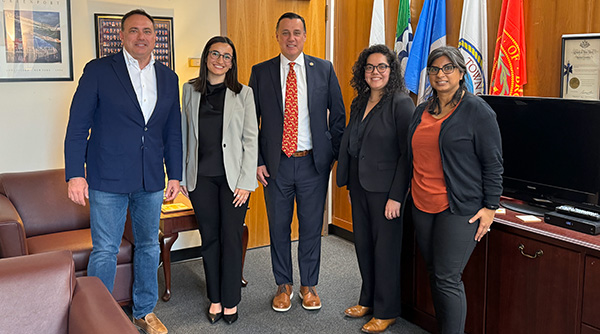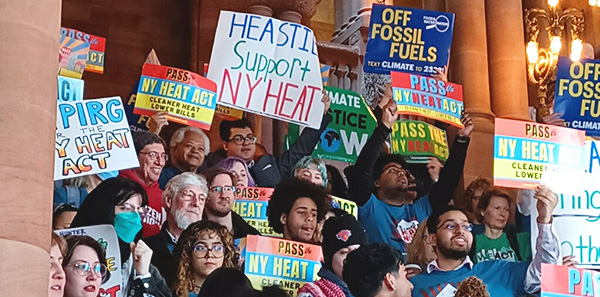
This email was sent by David Ansel, our vice president of water protection.
When policy intern Ella McGrail and I arrived at the Capitol on Monday, the clock was already ticking. Legislators had just returned to Albany after two weeks back home in their districts, and only 18 sessions remained on the legislative calendar.
It was time to get to work.
Ella and I were on hand for Rise to Resilience Advocacy Day. We spent the day meeting with assemblymembers, senators, and their staff about four bills focused on managing stormwater runoff, maximizing green infrastructure and nature-based solutions, and improving resiliency in the face of climate change.
Our New York policy team has participated in more than a half-dozen lobby days this session—with two more scheduled for next week—teaming with other environmental organizations to help shape and support a number of bills in the pipeline this session. We were successful in persuading the Legislature and Governor Kathy Hochul to maintain the record levels of funding for the Clean Water Infrastructure Act ($500 million) and the Environmental Protection Fund ($400 million), which support projects to improve wastewater, stormwater, and drinking water infrastructure. Now, we’re pushing to pass a variety of legislation that will benefit and protect Long Island Sound and its tributaries, the habitats that depend on clean, healthy waterways, and all communities in our region and across the state.
Here are the priority policy areas we will continue to focus our efforts through the end of the session on June 6:
Water Protection & Nitrogen Reduction
While we were in meetings during Monday’s Lobby Day, the Suffolk County Water Quality Restoration Act (S8473/A8993) was added to the Senate floor calendar. It passed the Assembly in mid-April, and we expect it will pass the Senate soon. We will then urge Governor Hochul to sign it into law, which would give the Suffolk County Legislature the green light to add a referendum to the November ballot. This bill creates an opportunity for Suffolk County voters to support expanding sewer coverage and replacing 380,000 outdated septic systems that are leaking wastewater into the groundwater and adding to a nitrogen pollution problem that residents have been enduring for decades. After this bill passes in Albany, you will be hearing much more about how to help pass it in Suffolk County.
Stormwater Management & Increased Resiliency
We’ve heard from so many legislators this session that their constituents’ No. 1 is flooding, which makes sense—every county in New York State has experienced a flood disaster declaration in the past decade. We continue to look for opportunities to ensure that any legislation aiming to protect people and property does so in a way that also protects water quality. Rain Ready New York (S8861A/A9435) confirms that sewer and water authorities across the state have the power to manage stormwater; this clarification will help these authorities address flooding caused by severe rain events and use green infrastructure to protect water quality.
The Climate Resilient New York Act of 2024 (S8158) would establish a statewide Office of Resilience run by a Chief Resilience Officer to identify climate-related threats. Through our coalition work, we made sure this bill gives the Officer jurisdiction to manage the response to storms as they’re happening, and that the importance of incorporating green infrastructure and nature-based solutions is emphasized in any resiliency plans.
We also support the Water Resiliency Projects Fund (S7764/A9121), which funds the Climate Resilient NY Act, and the Green Roof Abatement (S6409A/A6901A), which would incentivize the use of green infrastructure on the roofs of NYC buildings to manage stormwater runoff and reduce greenhouse gas emissions and the effects of urban heat islands.
Plastics, PFAS & Contaminants
If we are going to keep plastics and the toxic forever chemicals known as PFAS from polluting our waterways and creating ecological and public health crises, we have to turn off the tap on these contaminants.
The Packaging Reduction and Recycling Infrastructure Act (S4246B/A5322B) will cut plastic packaging waste in half in 12 years and eliminate the use of PFAS and other harmful chemicals in packaging material. A bill phasing out PFAS in Consumer and Household Products (S5648C/A3556C) takes a comprehensive approach similar to what Maine, Minnesota, and Washington have pioneered—and a comprehensive bill passed the Senate and House in Connecticut this week, both unanimously! There are several NY bills we support that would restrict the use of PFAS in specific product categories—PFAS in Personal Care and Cosmetic Products (S4265/A6969) and PFAS in Menstrual Products (S3529A/A5990A)—but we believe a single overarching law would be more effective.

Energy & Environmental Justice
We would have preferred that the NY Home Energy Affordable Transition Act—better known as the NY HEAT Act (S2016B/A4529B)—was included in the state budget, as the All-Electric Buildings Act was a year ago. The Senate supported including it in full, and the Governor supported components of it, but the Assembly didn’t want to include any of it. Now, we’re working to pass a bill that would reduce both emissions and energy costs through the Legislature.
Wildlife Conservation
This week, we’ll share with legislators a letter supporting a bill Protecting Horseshoe Crabs (S3185/A9842). It’s being amended and will now create a three-year ban on horseshoe crab harvesting in New York waters, which could help diminishing horseshoe crab populations begin to recover.
Thank you for taking action this session!
You’ve been hearing about many of these bills since before the session began back on January 3. Thank you for your support and for contacting your legislators and legislative leaders, helping us convey our shared budget goals and priority bills. You’ll be hearing more from us with new action opportunities in the coming weeks as we hope to help important new policies and protections become law in New York.
